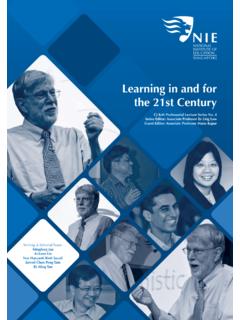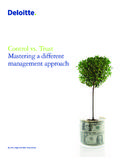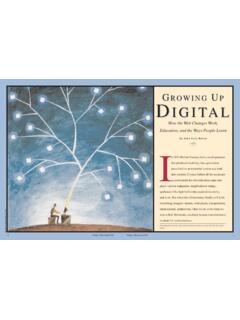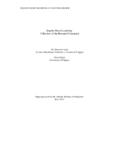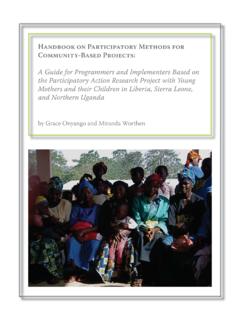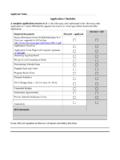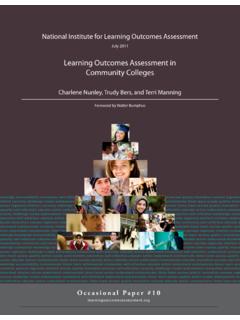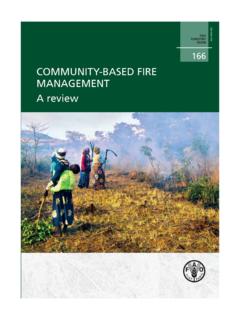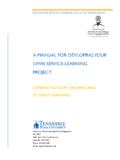Transcription of Learning in the Digital Age - John Seely Brown
1 Learning in the Digital AgeJohn Seely BrownLearning is a remarkably social truth, itoccurs not as a response to teaching, but rather as a resultof a social framework that fosters Learning . To succeed in ourstruggle to build technology and new media to support learn-ing, we must move far beyond the traditional view of teachingas delivery of information. Although information is a criticalpart of Learning , it s only one among many forces at work. It sprofoundly misleading and ineffective to separate information,theories, and principles from the activities and situationswithin which they are used. Knowledge is inextricably situatedin the physical and social context of its acquisition and and KnowledgeKey differences between the terms information and knowledge,which are often used interchangeably, are instructive. First,whereas information is usually considered independent of anyparticular individual it can be looked up in a book or re-trieved online knowledge is usually associated with a knower,65that is, it resides in someone s mind.
2 Second, given this per-sonal attachment, knowledge appears more difficult to detachthan information. It s harder, for example, to pick up, writedown, and transfer than information. Third, one reason knowl-edge may be so hard to give and receive is that it seems to beacquired more through assimilation. Knowledge is somethingwe digest rather than merely hold; it s usually deeply inter-twined with the knower s understanding of the practices sur-rounding its we look at teaching beyond the mere delivery of infor-mation, we see a rich picture of Learning , one that embracesthe social context, resources, background, and history withinwhich information resides. Knowledge, following MichaelPolanyi, can be thought of as having two dimensions: explicitand we think of knowledge as a tree, the explicit di-mension is like the leaves, branches, and trunk the partsabove ground.
3 The tacit dimension is like the roots buried be-low the surface and deeply immersed in the soil that makes itrobust. The explicit lives in books and in our brains as con-cepts and facts and deals with the know-what. The tacit dealswith the know-how that is best manifested in work practicesand skills. The tacit resides in action, most often in participa-tion with others. As a consequence, tacit knowledge can bedistributed as a shared, socially constructed understandingthat emerges from by doing with others offers students the opportu-nity for in-depth enculturation into a particular practice, where66the internet and the universityone learns to be a physicist, social scientist, historian, etc., incontrast to just Learning aboutsuch professions. Students couldabsorb the social and practical aspects of a profession (its prac-tices) and gain tremendously from their proximity to practition-ers, especially when they can watch, listen, and peripherallyparticipate.
4 Enculturation is crucial to such Learning , since rel-atively little of the complex web of practice can effectively bemade the subject of explicit instruction. A great deal of knowl-edge inevitably remains implicit in practice. The conventionalroute of trying to render the implicit explicit, which is the stan-dard alternative to enculturation, is highly Peripheral ParticipationJean Lave and Etienne Wenger sum up their view of learningas socially situated in their notion of legitimate peripheral par-ticipation (LPP). As they put it, Legitimate peripheral participation is .. an analytic view-point on Learning , a way of understanding Learning . We hopeto make it clear that Learning through legitimate peripheralparticipation takes place no matter which educational formprovides a context for Learning , or whether there is any in-tentional educational form at all.
5 Indeed, this viewpointmakes a fundamental distinction between Learning and in-tentional instruction. 367learning in the Digital ageConsistent with the tenets of LPP, it s through participationin communities that deep Learning occurs. People don t learnto become physicists by memorizing formulas; rather it s theimplicit practices that matter most. Indeed, knowing only theexplicit, mouthing the formulas, is exactly what gives an out-sider away. Insiders know more. By coming to inhabit the rele-vant community, they get to know not just the standard an-swers, but the real questions, sensibilities, and aesthetics, andwhy they relationship between Learning and credentials degreesand diplomas is problematic, precisely because students cangain credentials without having gained access to knowing com-munities. They can, and frequently do, end up with the rightlabel but without the experience it s meant to signify.
6 The realtest of a university is the community access it provides. Any at-tempt to retool the education system must retain not only itsdegree-granting feature, but must also involve expanding ac-cess to the communities of practice that comprise the univer-sity and not simply to the content of education today, which usually involves a form ofapprenticeship, offers the intensive, in-depth enculturationthat stems from participation in a particular community. Con-trary to popular assumptions that as people delve further into68the internet and the universityan academic field, they simply become more theoretical, thereality of graduate education today is that practice, not theory,is at the top of the first two years of undergraduate education, however, aredifferent. These undergraduates are, after all, the primary tar-gets of education s delivery mechanisms.
7 Fortunately for them(and for universities) life is full of unintended undergraduate curricula may be designed to delivermass quantities of predigested knowledge, to do so universitiesmust pull together practitioners from numerous specializedcommunities. This intermingling on campus enriches stu-dents opportunities for exposure to a variety of they progress through their undergraduate years and focuson a specific field of study, students also engage to some de-gree in a particular community, and begin to understand itscharacter and what joining it would entail. A diploma, then, isa reasonably safe indicator that its bearer has learned the rudi-ments of community joining that is, that he or she has begunto s the Learning communities that universities establish andnurture that remove them from the realm of a delivery service,or from being mere traffickers of information, to knowledgecreators.
8 An on-campus social Learning environment offers ex-posure to multiple communities of scholars and practices, giv-ing students broad access to people from different fields, back-grounds, and expectations, as well as opportunities forintensive study, all of which combine to form a creative tensionthat spawns new ideas, perspectives, and in the Digital ageDigital LearnersMany of the current, and certainly most of the next, genera-tion of students who reach college age are remarkably im-mersed in technology, far more so than we or other membersof any older generation can likely fathom. Today s Digital kidsthink of information and communications technology (ICT) assomething akin to oxygen: they expect it, it s what theybreathe, and it s how they live. They use ICT to meet, play,date, and learn. It s an integral part of their social life; it s howthey acknowledge each other and form their personal identi-ties.
9 Furthermore, ICT to some degree has been supportingtheir Learning activities since their first Web search and surfyears 1 shows a set of dimensional shifts that describe kidsin the Digital age. The dimensions are presented in turn, butthey actually fold in on each other, creating a complex set ofintertwined cognitive first dimensional shift encompasses the evolving natureof literacy, which today involves not only text but also imageand screen literacy. The ability to comprehend multimediatexts and to feel comfortable with new, multimedia genres isdecidedly nontrivial. Digital students have developed their ownvernacular, a screen languagefor their Digital culture. The abil-ity to communicate and express oneself with images (still andmoving), sound, and other media is a crucial aspect of the newliteracy. Beyond this, information navigation is perhaps the keycomponent of literacy in the Digital age.
10 Web-smart kids hone70the internet and the universitytheir judgment skills through experience and triangulation asthey surf the sheer scope and variety of resources the Webpresents, the magnitude of which largely befuddles the adultunfamiliar with Digital next dimension shifts Learning from an authority-basedlecture model to discovery-based Learning . Young learners areconstantly discovering new things as they browse throughemergent Digital libraries and other Web resources. Indeed,Web surfing fuses Learning and entertainment, third shift, pertaining to reasoning, connects to discov-ery-based Learning in an extremely important way. Classically,reasoning is linked with the deductive and abstract. Yet younglearners working with Digital media seem to focus more on theconcrete, suggesting a form of bricolage,a concept having todo with one s abilities to find something (perhaps a tool, someopen source code, images, music, text) that can be used or71learning in the Digital ageFigure 1.
